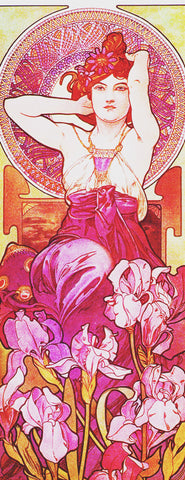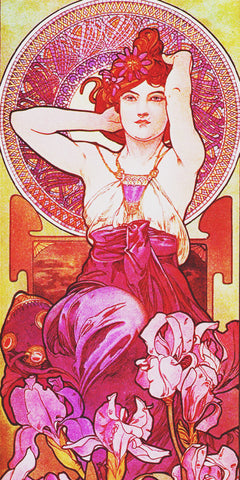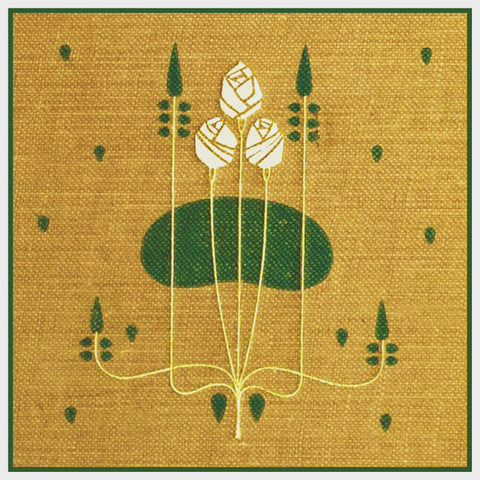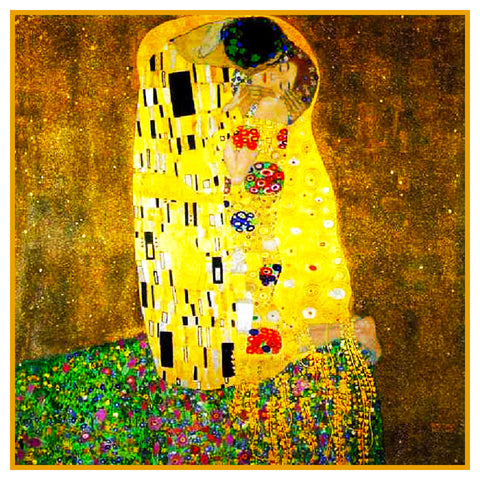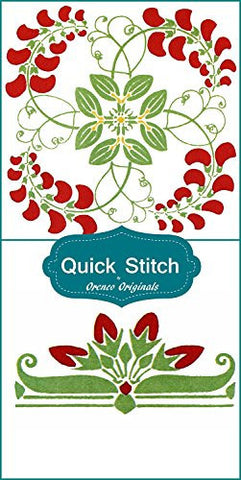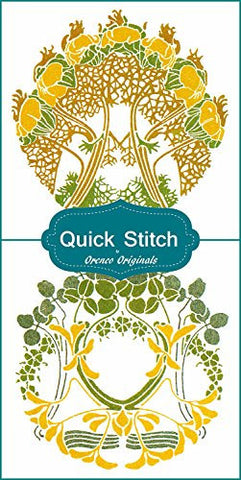Orenco Originals for the Artful Needleworker !
ART NOUVEAU INSPIRED Orenco Originals Counted Cross Stitch Patterns

Art Nouveau is an international style of art, architecture and applied art, especially the decorative arts, that was most popular between 1890 and 1910. A reaction to the academic art of the 19th century, it was inspired by natural forms and structures, particularly the curved lines of plants and flowers.
The French name Art Nouveau ("new art") is related to, but not identical with, styles that emerged in many countries in Europe at about the same time: in Austria it is known as Secessionsstil after Wiener Secession, in Spanish Modernismo, in Catalan Modernisme, in Czech Secese, in Danish Skønvirke or Jugendstil, in German Jugendstil, Art nouveau or Reformstil, in Hungarian Szecesszió, in Italian L'Art Nouveau, Stile floreale or Stile Liberty, in Norwegian Jugendstil, in Polish Secesja, in Slovak Secesia, in Russian Модерн (Modern), and Swedish Jugend.
Art Nouveau is considered a "total" art style, embracing architecture, graphic art, interior design, and most of the decorative arts including jewelry, furniture, textiles, household silver and other utensils, and lighting, as well as the fine arts. Per the philosophy of the style, art should be a way of life. For many well-off Europeans, it was possible to live in an art nouveau-inspired house with art nouveau furniture, silverware, fabrics, ceramics including tableware, jewelry, cigarette cases, etc. Artists desired to combine the fine arts and applied arts, even for utilitarian objects.
By 1910, Art Nouveau was already out of style. It was replaced as the dominant European architectural and decorative style first by Art Deco and then by Modernism.
Enjoy our Counted Cross Stitch Charts Patterns inspired by Art Nouveau Art works.
-
-
Alfons Mucha's Golden Pisces-Fish on a Blue Background Counted Cross Stitch Pattern
-
Alfons Mucha's Golden Pisces-Fish on a Green Background Counted Cross Stitch Pattern
-
Alfons Mucha's Golden Pisces-Fish on a Peach Background Counted Cross Stitch Pattern
-
Alfons Mucha's Golden Pisces-Fish on a Red Background Counted Cross Stitch Pattern
-
Alfons Mucha's Golden Pisces-Fish on a Red Background Counted Cross Stitch Pattern DIGITAL DOWNLOAD
-
-
Amethyst by Alphonse Mucha Counted Cross Stitch Pattern
-
Amethyst Maiden by Alphonse Mucha Counted Cross Stitch Pattern
-
Amethyst Maiden Detail by Alphonse Mucha Counted Cross Stitch Pattern
-
Art Nouveau 3 Gold Roses By Talwin Morris Arts and Crafts Style Counted Cross Stitch Pattern
-
Art Nouveau 3 White Roses By Talwin Morris Arts and Crafts Style Counted Cross Stitch Pattern
-
Art Nouveau 3 White Roses By Talwin Morris Arts and Crafts Style Counted Cross Stitch Pattern DIGITAL DOWNLOAD
-
Art Nouveau Artist Gustav Klimt The KISS Counted Cross Stitch Pattern
-
Art Nouveau Artist Gustav Klimt The KISS Counted Cross Stitch Pattern DIGITAL DOWNLOAD
-
Art Nouveau Artist Gustav Klimt The Kiss detail Counted Cross Stitch Pattern
-
Art Nouveau Artist Gustav Klimt The Kiss detail Counted Cross Stitch Pattern DIGITAL DOWNLOAD
-
Art Nouveau Artist Gustav Klimt's Hygeia Counted Cross Stitch Pattern
-
Art Nouveau Artist Gustav Klimt's Hygeia Counted Cross Stitch Pattern -18 Count
-
Art Nouveau Artist Gustav Klimt's Hygeia Counted Cross Stitch Pattern -18 Count DIGITAL DOWNLOAD
-
Art Nouveau Artist Gustav Klimt's Hygeia Counted Cross Stitch Pattern DIGITAL DOWNLOAD
-
Art Nouveau Artist Gustav Klimt's Judith in Gold Counted Cross Stitch Pattern
-
Art Nouveau Artist Gustav Klimt's Judith in Gold Counted Cross Stitch Pattern DIGITAL DOWNLOAD
-
Art Nouveau Artist Gustav Klimt's The Dancer Counted Cross Stitch Pattern
-
Art Nouveau Artist Gustav Klimt's The Dancer Counted Cross Stitch Pattern DIGITAL DOWNLOAD
-
Art Nouveau Artist Gustav Klimt's The Lady with the Hat and Boa Counted Cross Stitch Pattern
-
Art Nouveau Artist Gustav Klimt's The Lady with the Hat and Boa Counted Cross Stitch Pattern DIGITAL DOWNLOAD
-
Art Nouveau Birds and Roses By Talwin Morris Arts and Crafts Style Counted Cross Stitch Pattern
-
Art Nouveau Birds and Roses By Talwin Morris Arts and Crafts Style Counted Cross Stitch Pattern DIGITAL DOWNLOAD
-
Art Nouveau Bunny Rabbit by Pedro De Lemos Counted Cross Stitch Pattern
-
Art Nouveau Christmas by American Edward Penfield Counted Cross Stitch Pattern
-
Art Nouveau Colorful Parrot Tulips and Iris Flowers Counted Cross Stitch Pattern
-
Art Nouveau Decorative Screen detail inspired by Louis Comfort Tiffany Counted Cross Stitch Pattern
-
Art Nouveau Designs #1 Quick Stitch Flower 2 Counted Cross Stitch Patterns
-
Art Nouveau Designs #14 Quick Stitch Flower 2 Counted Cross Stitch Patterns
-
Art Nouveau Designs #2 Quick Stitch Flower Designs 2 Counted Cross Stitch Patterns
-
Art Nouveau Designs #3 Quick Stitch Flower 2 Counted Cross Stitch Patterns
-
Art Nouveau Designs #4 Quick Stitch Flower 2 Counted Cross Stitch Patterns
-
Art Nouveau Designs #5 Quick Stitch 2 Counted Cross Stitch Patterns
-
Art Nouveau Designs #6 Quick Stitch Flower 2 Counted Cross Stitch Patterns









